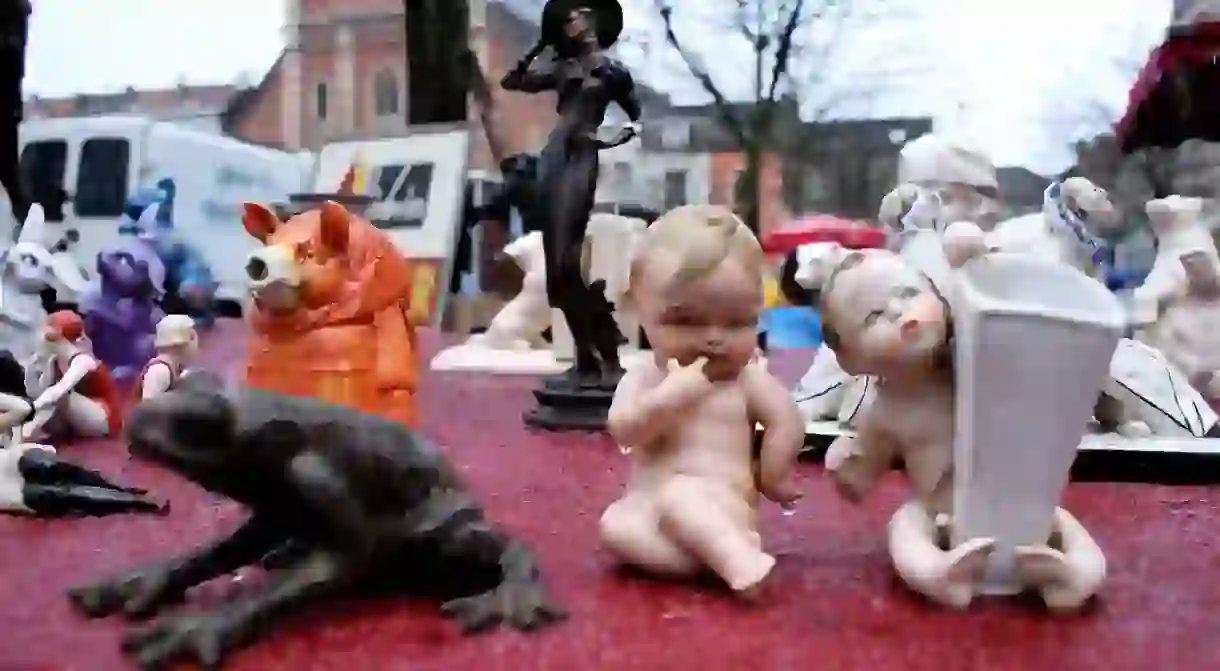Where to Find the Best Traditional Markets in Belgium

The hearts of knowledgeable brocanteurs and bargain hunters everywhere can’t help but beat for Belgium. In a land where every town of a respectable size has its own weekly market, these eight are absolute classics.
The Marolles’ Place du Jeu de Balle, Brussels
The one and only for many Bruxellois and certainly for the old Marolliens, the daily flea market on the Place du Jeu de Balle is as authentic as they come. From 6am-ish to noon – Christmas and New Year’s included – bric-a-brac vendors present their wares on blankets and rickety tables in the heart of the old Marolles neighborhood. The market, which first popped up during Great War times and hasn’t changed much since, is considered a hunter’s delight. Vintage treasure tends to hide between discarded lampshades, grandmother’s tableware and amateur paintings of Flemish farmland. Good finds go to the early birds, but a relaxed brunch-time stroll and rummage to soak up the atmosphere (made complete by fierce haggling bouts) is a thing of beauty on its own.

Ciney Flea Market and Antique Fair
The world of antiques is your oyster at Ciney’s sprawling four-day market. During this period over 700 international exhibitors strike down to display everything from the finest, genuine antique toys and dolls inside the Ciney Expo Hall, to tons of bargain objects outside on the parking lot. The fair only comes around twice a year: once in spring and once in autumn. For the quintessential Ciney experience, join the vintage-voracious crowd in rushing the trucks at 2pm sharp on opening day while they’re still being unpacked.
Tongeren’s Antique and Brocante Fair
Another fixed value in the hearts and minds of avid antique hunters as well as dealers is Tongeren, a small city close to the Dutch border. On Sunday before noon its central streets, squares and a couple of indoor halls are chockablock full of furniture. Big pieces in dark wood are a staple here, and from time to time you’ll bump into large industrial items such as a three-legged industrial spotlight. Hours easily while away at this out of the ordinary market that at times feels more ‘spoiled domestic cat’ than ‘flea’.

Antwerp’s Friday Market
Kitschy plates that are looking for a third or fourth family to serve, abandoned bedside tables that have been exchanged for younger, hipper models and the occasional antique bargain – Antwerp’s Friday market on the Vrijdagmarkt has been bringing together reusable objects since 1547. Nestled in the cozy lap of the Plantin Moretus museum, which houses some of the world’s oldest printing presses, the Friday market is a long-running tradition. With the most precious pieces getting auctioned off in tiny bidding wars and shopped-out bargain hunters taking a load off on the adjacent terraces, its dynamic spirit endures all day.

Antwerp’s Exotic Market
Antwerp’s Exotic Market, also known as the ‘Foreigner’s Market’, is a labyrinth of flavors and aromas. Moroccan herbs and spices, Greek olives and figs, dried French sausages, savory Turkish pancakes and curiously shaped fruits from distant lands turn the square underneath the City Theater into a journey around the world each Saturday afternoon. Belgium for its part gets represented by seasonal strawberries, homemade waffles and a lighthouse cranking out delicious croquettes by the dozen. To top off the vacation vibes, nearly all stands provide free tasters, and vendors stick around until 4pm. Go on an empty stomach and leave with the world in your belly.
Ostend’s Fish Stairs
With the expansion of Ostend’s harbor in the 19th century came an open-air fish market that’s stuck around ever since. Known as the ‘Vistrap’ or ‘fish stairs’, this is where the treasures of the North Sea land in all their fresh glory. The actual stairs the bazaar was named for has gone now, but the original tradition sailors had of selling the leftovers from their catch to locals by those stairs, has grown into a daily market that opens before dawn. Early risers get their pick of the best grey shrimp every day, at least if there was no storm out at sea the night before. The iconic Ostend building recently got a makeover and now wears a wave-shaped, bright blue roof.

Ghent’s Flower Market
Every day is flower day at Ghent’s Kouter square, but Sundays are when florists pull out all the stops. While they cover the square in colors and fragrances, the idyllic blue kiosk (De Blauwe Kiosk) offers up champagne and oysters for a particularly festive weekend morning, and a coffee stand foresees in the needs of espresso lovers in search of their morning hit. During the summer months, a brass band plays its heart out on the square’s other, cast-iron kiosk as it has done for well over a century.

Waterloo’s Broncante du Lion
Not too far from the Lion’s mound reminding visitors of Napoleon’s illustrious defeat on fields 30 minutes away from Brussels, one of the country’s largest weekly brocante markets unfolds on Sunday morning. Old home décor hardware such as coffee grinders, decorative doorknobs and old-timey clocks are in big supply here, and in a surprisingly neat stall configuration. A nostalgia-inducing home décor has never been attainable at such prices.













